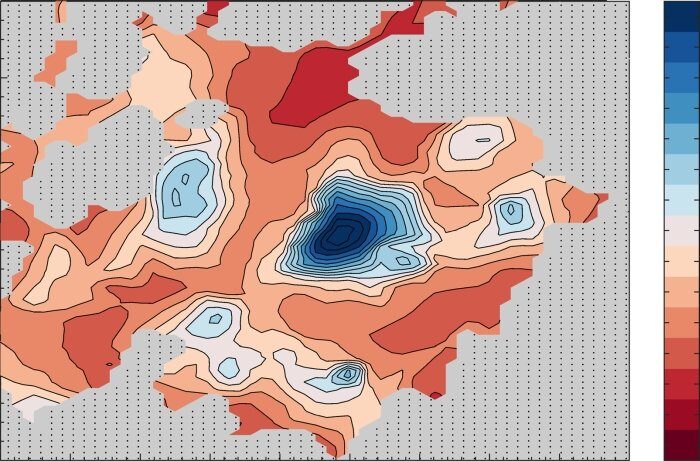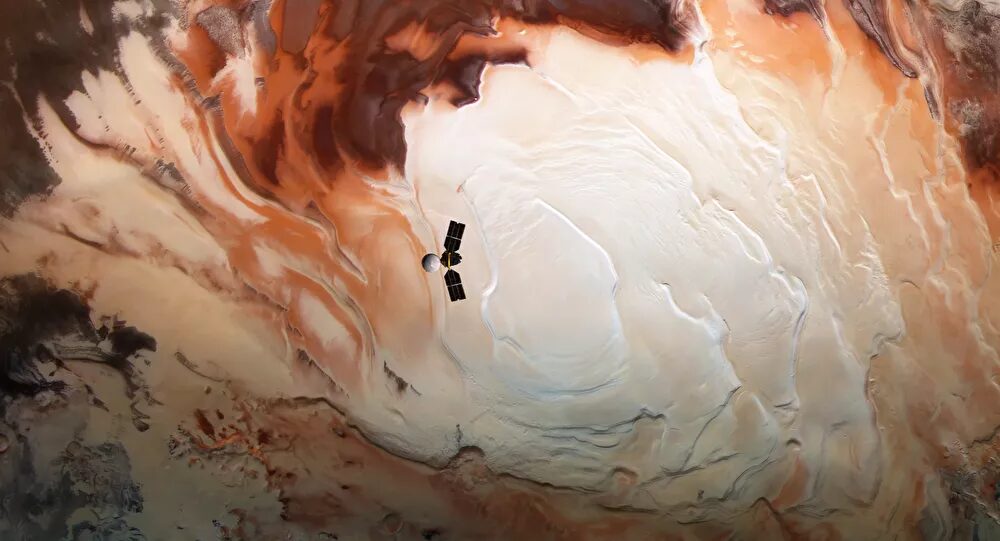But in 2018, scientists unveiled a bombshell discovery - they'd found evidence of a colossal underground reservoir of liquid water at the Martian south pole.
Now, they've taken that discovery a crucial step forward. There's not one, but an entire network of multiple lakes under the southern polar ice cap. And that means that the first reservoir was not a one-off or a freak of Martian nature.
"The existence of a single subglacial lake could be attributed to ad-hoc conditions such as the presence of a volcano under the ice sheet, or some other situation unique to the specific location where we found the first subglacial lake," explained geophysicist Elena Pettinelli of Roma Tre University in Italy to ScienceAlert. She led the research alongside colleague Sebastian Emanuel Lauro.
"The discovery of an entire system of lakes instead, suggests their formation process to be relatively simple and possibly common."
The first subglacial lake was announced just over two years ago. It was discovered using the Mars Advanced Radar for Subsurface and Ionosphere Sounding (MARSIS) instrument on the Mars Express orbiter.
This uses the same technique we use to find subglacial lakes in Antarctica - bouncing radio waves off a surface and measuring the echoes, looking for changes in the signal to characterise a topography.
These radar sounding investigations initially revealed a single subglacial lake 1.5 kilometres (0.93 miles) under the southern polar ice cap, measuring 20 kilometres (12.4 miles) across.
"Some types of material reflect radar signals better than others, and liquid water is one of those 'materials'," one of the researchers, planetary scientist Graziella Caparelli of the University of Southern Queensland in Australia, told ScienceAlert.
"Therefore, when the signals coming from the subsurface are stronger than those reflected by the surface, we can confirm that we are in the presence of liquid water. Radars are used on Earth (where we can directly verify the results) for the same purpose, so we are certain that the technique is reliable."
Since then, the team has performed more investigations on a dataset spanning almost a decade, from 2010 and 2019. And, in a new analysis of those data, they found three new brightly reflecting patches.
In other words, a network of subglacial lakes separated by regions of dry stone, hidden away under the south pole, not far from that initial lake.

"Importantly, we have obtained the same results using more advanced data processing and analysis methods than for our 2018 paper, and the fact that, having run such a rigorous data analysis process, we confirmed the presence of that lake, and found other lakes, makes us quite confident about our interpretation that the liquid is water."
Moreover, if it is liquid water, it's likely salty water. Extremely salty water. Mars, you see, is very cold, and even though the interior is warmer than the surface, it's still cold enough to freeze fresh water. In 2018, the team estimated that the lake they found would be around 205 Kelvin (-68.15 degrees Celsius, or -90.67 degrees Fahrenheit).
But salt lowers the freezing point of water, and can do quite significantly. As the team note in their paper, water imbued with salts of calcium and magnesium can remain liquid at temperatures as low as 150 Kelvin, for very long periods of time. And Mars, as we know from exploring the surface, is rich in salts of calcium and magnesium, as well as sodium.
So the discovery of additional salty subglacial lakes is very significant. It means that they can form easily and hang around for geological timescales - which is an important piece in the longstanding puzzle of Mars' water and climate history. And it also has important implications in the search for Mars microbes.
"These lakes have probably existed for much of Mars' history," said planetary scientist Roberto Orosei of the National Institute for Astrophysics in Italy, and principal investigator for MARSIS.
"For this reason, they could still retain traces of any life forms that could have evolved when Mars had a dense atmosphere, a milder climate and the presence of liquid water on the surface, similar to the early Earth."
It's possible, even, that microbial life may still be thriving in those lakes.
We know that such can live in some of the most salty, inhospitable places Earth has to offer, as well as subglacial reservoirs. Of course, we're a very, very long way from making such a detection, and studying Mars water up close may contravene the 1967 Outer Space Treaty. But it's worth thinking about.
The next step the team is taking is to search for water elsewhere on Mars. It's unclear whether underground reservoirs could exist at lower latitudes, but the north pole has a hefty ice cap of its own.
"It is not implausible that basal lakes also exist beneath the north polar ice cap,'' Caparelli said.
"Data analysis of a few data acquired in the same way we acquired those that allowed us to 'see' the south polar subglacial lakes has only just begun, however."
So we'll be eagerly awaiting to see those results when the team has analysed them. Meanwhile, in an ideal world, Pettinelli would love to send up landers to conduct seismic monitoring to plumb the depths of those reservoirs.
"Active seismic prospecting techniques such as those commonly used on Earth to discover oil reservoirs would be best and have been used in Antarctica to detect the bottom of the lakes. These techniques could shed light on the water depth and the geometry of the water bodies," she told ScienceAlert.
However, as Mars landers are difficult and expensive, and the seismic monitors would be challenging to set up, we may be waiting a long time for that one.
The research has been published in Nature Astronomy.




Comment: From the European Space Agency: